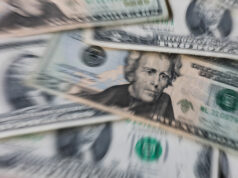THE PESO weakened on Thursday after data showed first-quarter gross domestic product (GDP) slumped for the first time since 1998 due to global supply chain disruptions and the onset of the Luzon lockdown.
The local unit ended at P50.56 per dollar yesterday, depreciating by 10 centavos from Wednesday’s close of P50.46 against the greenback, data from the Bankers Association of the Philippines showed.
The local currency opened the trading day at P50.54 per dollar, weakening to as low as P50.57, while its strongest showing stood at P50.48 per dollar.
Dollars traded inched up to $558.39 million from the $539.19 million posted the day prior.
Rizal Commercial Banking Corp. Chief Economist Michael L. Ricafort attributed the weaker peso to the lower-than-expected GDP data released earlier that day.
Using the new base year of 2018, the Philippine Statistics Authority (PSA) reported Thursday that first-quarter GDP contracted by 0.2% year on year coming from the 6.7% and 5.7% growth reported in the fourth quarter and in the first quarter of 2019, respectively.
The contraction was the first time the country’s economic output declined since the three-percent contraction in the fourth quarter of 1998.
Mr. Ricafort said the first quarter contraction was mainly due to disruptions in production and supply chains here and overseas when the Luzon lockdown started in the last two weeks of March.
“This was also partly brought about by the economic damage/disruptions brought about by the Taal volcanic eruption and the lockdown in China, the world’s second-biggest economy, for most of 1Q 2020, followed by lockdowns in many other countries around the world that resulted to year-on-year contractions in tourism, manufacturing, and trade especially exports and imports,” he said.
Of the major economic sectors, services managed to grow by 1.4% year on year albeit at a slower pace than 7.1% seen a year ago. Meanwhile, agriculture and industry sectors declined by 0.4% and three percent, respectively.
On the spending side, household consumption recorded a flat 0.2% growth while government expenditures rose 7.1%, both slowing down from the previous quarter’s growth of 6.2% and 17%, respectively.
“Peso (was) also weaker after some upward correction in global crude oil prices recently to three-week highs,” Mr. Ricafort added in a mobile phone message.
Meanwhile, a trader said another factor that the market might have priced in was the “grim US labor reports” that will be out Friday evening.
Mr. Ricafort expects the peso to trade within the P50.40-50.65 per dollar levels on Friday while the trader sees it settling between P50.50 and P50.70. — Beatrice M. Laforga



